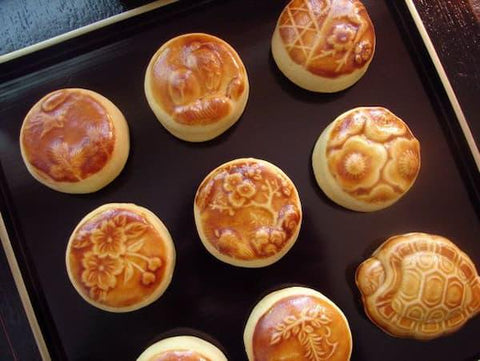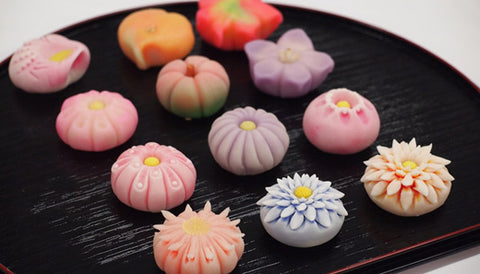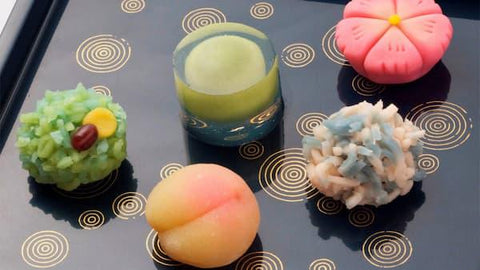Das Land der aufgehenden Sonne – Japan ist berühmt für seine vielfältige und einzigartige Küche. Eines davon ist Wagashi-Kuchen. Japanisches Wagashi ist ein beliebter japanischer Snack, der typischerweise Süßigkeiten aus Zucker, Sirup und „An“ (süße rote Bohnenpaste) enthält. Darüber hinaus finden Sie köstliche Leckereien, die mit Salz und Sojasauce aromatisiert sind, darunter Enbei und Arare (Reiskuchen) und Dango (Knödel). Wagashi-Kuchen sind seit Jahrhunderten ein fester Bestandteil der japanischen Kultur und werden oft bei Teezeremonien oder als süße Leckerei für besondere Anlässe serviert. Finden wir die interessanten Dinge rund um diesen traditionellen Kuchen mit Japan With Love Store heraus.
1. Was ist Wagashi?
Die Geschichte von Wagashi lässt sich bis in die Antike Japans zurückverfolgen. Die Wurzeln von Wagashi liegen in buddhistischen Ritualen und Teezeremonien, bei denen das Anbieten und der Verzehr von Süßigkeiten eine wichtige Rolle spielten.
Die Einführung von Zucker und raffinierten Süßigkeiten aus China während der Nara-Zeit (710-794) inspirierte die Entwicklung von Wagashi. Allerdings begann japanisches Wagashi während der Edo-Zeit (1603-1868), seine besonderen Eigenschaften und regionalen Variationen anzunehmen.

Eine beliebte japanische Süßigkeit ist Wagashi
Während der Meiji-Zeit (1868-1912) wurde der Begriff Wagashi geprägt, um japanische Süßigkeiten von den europäischen zu unterscheiden, die nach Japan importiert wurden. Wie schmeckt Wagashi? Die Textur dieser Leckereien ist herrlich weich und flockig mit einem Hauch von Süße. Die Formen dieser Süßigkeiten waren ursprünglich von chinesischen Süßwaren und Dim Sum inspiriert, aber Wagashi hat sich seitdem weiterentwickelt und ist ausdrucksstärker und einzigartig japanisch geworden.
Wagashis Verbindung zur Teezeremonie verstärkte seinen Status als Kunstform zusätzlich. Wagashis minimalistische und harmonische Natur steht im Einklang mit den ästhetischen Prinzipien der Teezeremonie und betont Einfachheit, Schönheit und Achtsamkeit.
Heute wird Wagashi Japanese immer noch als köstliches Gericht und Ausdruck der japanischen Kultur genossen. Es wird oft mit grünem Tee serviert oder als eigenständiges Dessert genossen, das nicht nur für seinen Geschmack, sondern auch für seine Handwerkskunst und kulturelle Bedeutung geschätzt wird.
2. Zutaten von Wagashi
Für die Herstellung von Wagashi werden verschiedene Zutaten verwendet, abhängig von der spezifischen Art von Wagashi Japanese, die zubereitet wird. Hier sind jedoch einige häufige Zutaten, die in vielen Wagashi-Rezepten zu finden sind:
- Süße Bohnenpaste (Anko): Süße Bohnenpaste ist ein wesentlicher Bestandteil von Wagashi und wird typischerweise aus gekochten und gesüßten Azuki-Bohnen hergestellt. Es gibt verschiedene Arten von Anko, darunter glatte (Koshi-An) und stückige (Tsubu-An), die eine Reihe von Texturen bieten.
- Reismehl: Reismehl, oft Klebreismehl (Mochiko), wird verwendet, um den äußeren Teig oder die äußere Hülle bestimmter Wagashi herzustellen. Es sorgt für eine weiche und zähe Textur.
- Zucker: Zucker wird verwendet, um die Bohnenpaste und andere Bestandteile von Wagashi zu süßen. Es kann der Bohnenpaste während des Kochvorgangs zugesetzt oder auf die äußere Oberfläche gestreut werden.
- Agar oder Gelatine: Diese Geliermittel werden manchmal verwendet, um bestimmten Arten von Wagashi Form und Struktur zu verleihen. Sie tragen dazu bei, eine feste und geleeartige Textur zu erzeugen.
- Matcha (gemahlener grüner Tee): Matcha wird oft in Wagashi eingearbeitet und verleiht ihm eine leuchtend grüne Farbe und einen subtilen, erdigen Geschmack. Es wird im Teig, in Füllungen oder zum Bestäuben der äußeren Oberfläche verwendet.
- Früchte und natürliche Aromen: Einige Wagashi enthalten Früchte wie Sakura (Kirschblüten), Yuzu (Zitrusfrüchte) oder Kastanien als Aromen oder Garnierungen. Diese Zutaten verleihen den Konfekten einen einzigartigen und erfrischenden Geschmack.
- Sojabohnenmehl (Kinako): Kinako, geröstetes Sojabohnenmehl, wird häufig als Überzug für Wagashi verwendet. Es verleiht einen nussigen Geschmack und verbessert die Gesamttextur.
Dies sind nur einige Beispiele für die in Wagashi verwendeten Zutaten. Verschiedene Arten von Japan Wagashi können zusätzliche Zutaten wie Sesamsamen, Agar-Agar, essbare Blüten oder sogar Sake-Hefe enthalten, was zu einer großen Vielfalt an Aromen und Texturen führt.
3. Etikette und Werkzeuge für den Genuss von Wagashi
Japan Wagashi Süßigkeiten passen am besten zu grünem Tee. Es gibt jedoch bestimmte Regeln, die beim Verzehr dieser Konfekte zu beachten sind, abhängig vom Anlass. Bei formellen Zeremonien wird Wagashi auf kleinen einzelnen Tellern oder in einer großen flachen Schüssel für mehrere Gäste serviert.
Wagashi wird von den Japanern oft mit grünem Tee serviert
Um Wagashi richtig zu genießen, verwendet die japanische Kultur traditionelle Utensilien wie Kuromoji und Youji. Diese flachen Werkzeuge, die Miniaturmessern ähneln, werden verwendet, um die Süßigkeiten zu schneiden und aufzunehmen. Edelstahl ist das Hauptmaterial, aus dem Youjis hergestellt werden, während Kuromojis aus Holz hergestellt werden.
Denken Sie daran, Geduld zu üben, auch wenn Sie versucht sind, sich dem Wagashi hinzugeben. Es ist wichtig, auf die Worte des Teeservierers „Wagashi o Douzo“ (Bitte genießen Sie die Süßigkeiten) zu warten, bevor Sie mit dem Verzehr beginnen.
4. Arten von Wagashi
Wagashi gibt es in vielen Formen, Größen und Geschmacksrichtungen, mit einzigartigen Variationen, die in verschiedenen Regionen und Jahreszeiten zu finden sind. Hier sind einige der beliebtesten Arten für jeden Geschmack und jede Vorliebe.
4.1. Dango

Dango sind kleine gedämpfte Mochi-Kuchen, die auf einem Spieß mit drei oder vier Knödeln serviert werden.
Dango ist die häufigste Art von Wagashi. Diese zähen runden Mochi-Bällchen am Stiel sind mit einem süß-salzigen Sirup aus Sojasauce, Zucker und Stärke überzogen. Man findet sie das ganze Jahr über auf Festivals oder in Convenience-Stores.
4.2. Daifuku

Daifuku wird normalerweise als Limited-Edition-Produkt für eine Saison von Winter bis Frühling verkauft
Daifuku ist ein kleiner runder Mochi, gefüllt mit einer süßen Füllung, normalerweise roter Bohnenpaste. Der Name bedeutet wörtlich übersetzt „großes Glück“, also ist Daifuku Mochi „großer Glücksreiskuchen“. Es gibt ihn in vielen Geschmacksrichtungen, wobei die häufigsten Ichigo (Erdbeere) Daifuku und Mame (Sojabohne) Daifuku sind.
4.3. Manju

Manju ist ein runder gedämpfter Kuchen, der normalerweise mit süßer roter Bohnenpaste gefüllt ist.
Manju ist ein Gebäck, das mit geknetetem Teig überzogen und mit aromatisierten Zutaten wie Anko, Kastanienmarmelade oder Süßkartoffel gefüllt ist. Es wird normalerweise gedämpft und variiert je nach Region.
4.4. Dorayaki

Süße rote Bohnenpaste ist essentiell für Dorayaki
Dorayaki ist ein Kuchen aus süßer roter Bohnenpaste, der zwischen zwei Schichten fluffigen Biskuitkuchens liegt. Der Name „dora“ bedeutet auf Japanisch Gong, was seine Form widerspiegelt, und „yaki“ bedeutet backen.
4.5. Namagashi

Namagashi ist anders und wunderschön geformt
Namagashi ist eine Art von Wagashi, das als essbares Kunstwerk gilt, mit wunderschönen saisonalen Designs wie Blumen und Blättern. Es ist besonders beliebt bei japanischen Teezeremonien und ist das delikateste aller Wagashi-Arten, das eine tägliche Zubereitung und den Verzehr im frischen Zustand erfordert.
4.6. Taiyaki

Andere Taiyaki enthalten Vanillepudding, Käse oder Schokoladeneis.
Taiyaki ist ein japanischer Kuchen in Fischform, der dem Rotbrassenfisch ähnelt. Traditionell wird es mit Anko-Paste aus roten Bohnen gefüllt, aber man findet Taiyaki auch mit Schokolade, Matcha und sogar Eiscreme gefüllt.
5. Wie kann man Wagashi kaufen?
Wagashi ist in ganz Japan beliebt geworden und ist heute in einer Reihe von Cafés, Restaurants, Tempeln und Gärten, in denen Tee serviert wird, leicht zu finden. Wenn Sie Kyoto besuchen, ist die Erkundung der vielen traditionellen Snackläden der Stadt eine großartige Möglichkeit, Wagashi zu erleben.

Wagashi wird an vielen Orten in Japan verkauft
In Tokio ist die Nakamise-Einkaufsstraße in Asakusa ein idealer Ort, um diese Speisen zu probieren. Sie sind auch eine beliebte Geschenkwahl, die man von Geschäftsreisen mitbringen kann, und sind oft in japanischen Kaufhäusern an großen Bahnhöfen zu finden.
Für diejenigen, die mehr über Wagashi erfahren möchten, gibt es viele traditionelle Wagashi-Herstellungskurse, die von zertifizierten Ausbildern unterrichtet werden. In diesen Kursen können die Teilnehmer etwas über die Bedeutung von Wagashi lernen und sogar die Speisen aus eigener Herstellung genießen.






















Teilen:
30+ inspirierende Selbstpflege-Zitate zur Pflege von Geist, Körper und Seele
Japan mit Liebe neu gestalten: Eine Reise voller Überraschungen und besserer E-Commerce-UX!